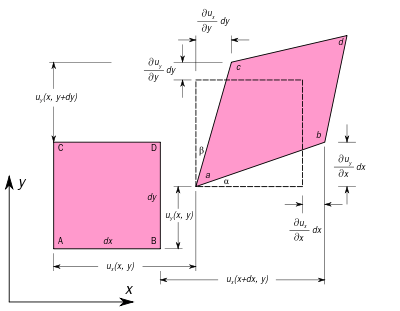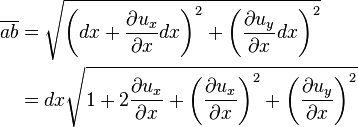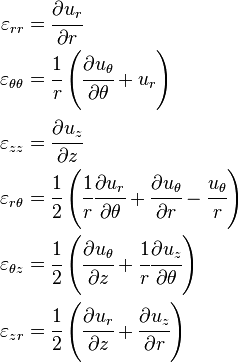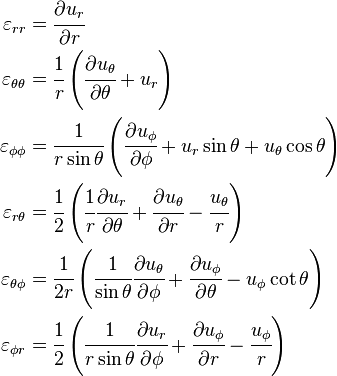Infinitesimal strain theory
| Continuum mechanics | ||||
|---|---|---|---|---|
 | ||||
|
Laws
|
||||
In continuum mechanics, the infinitesimal strain theory is a mathematical approach to the description of the deformation of a solid body in which the displacements of the material particles are assumed to be much smaller (indeed, infinitesimally smaller) than any relevant dimension of the body; so that its geometry and the constitutive properties of the material (such as density and stiffness) at each point of space can be assumed to be unchanged by the deformation.
With this assumption, the equations of continuum mechanics are considerably simplified. This approach may also be called small deformation theory, small displacement theory, or small displacement-gradient theory. It is contrasted with the finite strain theory where the opposite assumption is made.
The infinitesimal strain theory is commonly adopted in civil and mechanical engineering for the stress analysis of structures built from relatively stiff elastic materials like concrete and steel, since a common goal in the design of such structures is to minimize their deformation under typical loads.
Infinitesimal strain tensor
For infinitesimal deformations of a continuum body, in which the displacement (vector) and the displacement gradient (2nd order tensor) are small compared to unity, i.e.,  and
and  , it is possible to perform a geometric linearization of any one of the (infinitely many possible) strain tensors used in finite strain theory, e.g. the Lagrangian strain tensor
, it is possible to perform a geometric linearization of any one of the (infinitely many possible) strain tensors used in finite strain theory, e.g. the Lagrangian strain tensor  , and the Eulerian strain tensor
, and the Eulerian strain tensor  . In such a linearization, the non-linear or second-order terms of the finite strain tensor are neglected. Thus we have
. In such a linearization, the non-linear or second-order terms of the finite strain tensor are neglected. Thus we have
or
and
or
This linearization implies that the Lagrangian description and the Eulerian description are approximately the same as there is little difference in the material and spatial coordinates of a given material point in the continuum. Therefore, the material displacement gradient components and the spatial displacement gradient components are approximately equal. Thus we have
or

where  are the components of the infinitesimal strain tensor
are the components of the infinitesimal strain tensor  , also called Cauchy's strain tensor, linear strain tensor, or small strain tensor.
, also called Cauchy's strain tensor, linear strain tensor, or small strain tensor.
or using different notation:
Furthermore, since the deformation gradient can be expressed as  where
where  is the second-order identity tensor, we have
is the second-order identity tensor, we have
Also, from the general expression for the Lagrangian and Eulerian finite strain tensors we have
Geometric derivation of the infinitesimal strain tensor

Consider a two-dimensional deformation of an infinitesimal rectangular material element with dimensions  by
by  (Figure 1), which after deformation, takes the form of a rhombus. From the geometry of Figure 1 we have
(Figure 1), which after deformation, takes the form of a rhombus. From the geometry of Figure 1 we have
For very small displacement gradients, i.e.,  , we have
, we have
The normal strain in the  -direction of the rectangular element is defined by
-direction of the rectangular element is defined by
and knowing that  , we have
, we have
Similarly, the normal strain in the  -direction, and
-direction, and  -direction, becomes
-direction, becomes
The engineering shear strain, or the change in angle between two originally orthogonal material lines, in this case line  and
and  , is defined as
, is defined as
From the geometry of Figure 1 we have
For small rotations, i.e.  and
and  are
are  we have
we have
and, again, for small displacement gradients, we have
thus
By interchanging  and
and  and
and  and
and  , it can be shown that
, it can be shown that 
Similarly, for the  -
- and
and  -
- planes, we have
planes, we have
It can be seen that the tensorial shear strain components of the infinitesimal strain tensor can then be expressed using the engineering strain definition,  , as
, as
![\left[\begin{matrix}
\varepsilon_{xx} & \varepsilon_{xy} & \varepsilon_{xz} \\
\varepsilon_{yx} & \varepsilon_{yy} & \varepsilon_{yz} \\
\varepsilon_{zx} & \varepsilon_{zy} & \varepsilon_{zz} \\
\end{matrix}\right] = \left[\begin{matrix}
\varepsilon_{xx} & \gamma_{xy}/2 & \gamma_{xz}/2 \\
\gamma_{yx}/2 & \varepsilon_{yy} & \gamma_{yz}/2 \\
\gamma_{zx}/2 & \gamma_{zy}/2 & \varepsilon_{zz} \\
\end{matrix}\right]\,\!](../I/m/fbcb870bd30130506b80154d124a41b3.png)
Physical interpretation of the infinitesimal strain tensor
From finite strain theory we have
For infinitesimal strains then we have
Dividing by  we have
we have
For small deformations we assume that  , thus the second term of the left hand side becomes:
, thus the second term of the left hand side becomes:  .
.
Then we have
where  , is the unit vector in the direction of
, is the unit vector in the direction of  , and the left-hand-side expression is the normal strain
, and the left-hand-side expression is the normal strain  in the direction of
in the direction of  . For the particular case of
. For the particular case of  in the
in the  direction, i.e.
direction, i.e.  , we have
, we have
Similarly, for  and
and  we can find the normal strains
we can find the normal strains  and
and  , respectively. Therefore, the diagonal elements of the infinitesimal strain tensor are the normal strains in the coordinate directions.
, respectively. Therefore, the diagonal elements of the infinitesimal strain tensor are the normal strains in the coordinate directions.
Strain transformation rules
If we choose an orthonormal coordinate system ( ) we can write the tensor in terms of components with respect to those base vectors as
) we can write the tensor in terms of components with respect to those base vectors as
In matrix form,
We can easily choose to use another orthonormal coordinate system ( ) instead. In that case the components of the tensor are different, say
) instead. In that case the components of the tensor are different, say
The components of the strain in the two coordinate systems are related by
where the Einstein summation convention for repeated indices has been used and  . In matrix form
. In matrix form
or
Strain invariants
Certain operations on the strain tensor give the same result without regard to which orthonormal coordinate system is used to represent the components of strain. The results of these operations are called strain invariants. The most commonly used strain invariants are
In terms of components
Principal strains
It can be shown that it is possible to find a coordinate system ( ) in which the components of the strain tensor are
) in which the components of the strain tensor are
The components of the strain tensor in the ( ) coordinate system are called the principal strains and the directions
) coordinate system are called the principal strains and the directions  are called the directions of principal strain. Since there are no shear strain components in this coordinate system, the principal strains represent the maximum and minimum stretches of an elemental volume.
are called the directions of principal strain. Since there are no shear strain components in this coordinate system, the principal strains represent the maximum and minimum stretches of an elemental volume.
If we are given the components of the strain tensor in an arbitrary orthonormal coordinate system, we can find the principal strains using an eigenvalue decomposition determined by solving the system of equations
This system of equations is equivalent to finding the vector  along which the stress tensor becomes a pure stretch with no shear component.
along which the stress tensor becomes a pure stretch with no shear component.
Volumetric strain
The dilatation (the relative variation of the volume) is the trace of the tensor:
Actually, if we consider a cube with an edge length a, it is a quasi-cube after the deformation (the variations of the angles do not change the volume) with the dimensions  and V0 = a3, thus
and V0 = a3, thus
as we consider small deformations,
therefore the formula.

Real variation of volume (top) and the approximated one (bottom): the green drawing shows the estimated volume and the orange drawing the neglected volume
In case of pure shear, we can see that there is no change of the volume.
Strain deviator tensor
The infinitesimal strain tensor  , similarly to the Cauchy stress tensor, can be expressed as the sum of two other tensors:
, similarly to the Cauchy stress tensor, can be expressed as the sum of two other tensors:
- a mean strain tensor or volumetric strain tensor or spherical strain tensor,
 , related to dilation or volume change; and
, related to dilation or volume change; and - a deviatoric component called the strain deviator tensor,
 , related to distortion.
, related to distortion.
where  is the mean strain given by
is the mean strain given by
The deviatoric strain tensor can be obtained by subtracting the mean strain tensor from the infinitesimal strain tensor:
Octahedral strains
Let ( ) be the directions of the three principal strains. An octahedral plane is one whose normal makes equal angles with the three principal directions. The engineering shear strain on an octahedral plane is called the octahedral shear strain and is given by
) be the directions of the three principal strains. An octahedral plane is one whose normal makes equal angles with the three principal directions. The engineering shear strain on an octahedral plane is called the octahedral shear strain and is given by
where  are the principal strains.
are the principal strains.
The normal strain on an octahedral plane is given by
Equivalent strain
A scalar quantity called the equivalent strain, or the von Mises equivalent strain, is often used to describe the state of strain in solids. Several definitions of equivalent strain can be found in the literature. A definition that is commonly used in the literature on plasticity is
This quantity is work conjugate to the equivalent stress defined as
Compatibility equations
For prescribed strain components  the strain tensor equation
the strain tensor equation  represents a system of six differential equations for the determination of three displacements components
represents a system of six differential equations for the determination of three displacements components  , giving an over-determined system. Thus, a solution does not generally exist for an arbitrary choice of strain components. Therefore, some restrictions, named compatibility equations, are imposed upon the strain components. With the addition of the three compatibility equations the number of independent equations is reduced to three, matching the number of unknown displacement components. These constraints on the strain tensor were discovered by Saint-Venant, and are called the "Saint Venant compatibility equations".
, giving an over-determined system. Thus, a solution does not generally exist for an arbitrary choice of strain components. Therefore, some restrictions, named compatibility equations, are imposed upon the strain components. With the addition of the three compatibility equations the number of independent equations is reduced to three, matching the number of unknown displacement components. These constraints on the strain tensor were discovered by Saint-Venant, and are called the "Saint Venant compatibility equations".
The compatibility functions serve to assure a single-valued continuous displacement function  . If the elastic medium is visualised as a set of infinitesimal cubes in the unstrained state, after the medium is strained, an arbitrary strain tensor may not yield a situation in which the distorted cubes still fit together without overlapping.
. If the elastic medium is visualised as a set of infinitesimal cubes in the unstrained state, after the medium is strained, an arbitrary strain tensor may not yield a situation in which the distorted cubes still fit together without overlapping.
In index notation, the compatibility equations are expressed as
Engineering notation 





Special cases
Plane strain

In real engineering components, stress (and strain) are 3-D tensors but in prismatic structures such as a long metal billet, the length of the structure is much greater than the other two dimensions. The strains associated with length, i.e., the normal strain  and the shear strains
and the shear strains  and
and  (if the length is the 3-direction) are constrained by nearby material and are small compared to the cross-sectional strains. Plane strain is then an acceptable approximation. The strain tensor for plane strain is written as:
(if the length is the 3-direction) are constrained by nearby material and are small compared to the cross-sectional strains. Plane strain is then an acceptable approximation. The strain tensor for plane strain is written as:
in which the double underline indicates a second order tensor. This strain state is called plane strain. The corresponding stress tensor is:
in which the non-zero  is needed to maintain the constraint
is needed to maintain the constraint  . This stress term can be temporarily removed from the analysis to leave only the in-plane terms, effectively reducing the 3-D problem to a much simpler 2-D problem.
. This stress term can be temporarily removed from the analysis to leave only the in-plane terms, effectively reducing the 3-D problem to a much simpler 2-D problem.
Antiplane strain
Antiplane strain is another special state of strain that can occur in a body, for instance in a region close to a screw dislocation. The strain tensor for antiplane strain is given by
Infinitesimal rotation tensor
The infinitesimal strain tensor is defined as
Therefore the displacement gradient can be expressed as
where
The quantity  is the infinitesimal rotation tensor. This tensor is skew symmetric. For infinitesimal deformations the scalar components of
is the infinitesimal rotation tensor. This tensor is skew symmetric. For infinitesimal deformations the scalar components of  satisfy the condition
satisfy the condition  . Note that the displacement gradient is small only if both the strain tensor and the rotation tensor are infinitesimal.
. Note that the displacement gradient is small only if both the strain tensor and the rotation tensor are infinitesimal.
The axial vector
A skew symmetric second-order tensor has three independent scalar components. These three components are used to define an axial vector,  , as follows
, as follows
where  is the permutation symbol. In matrix form
is the permutation symbol. In matrix form
The axial vector is also called the infinitesimal rotation vector. The rotation vector is related to the displacement gradient by the relation
In index notation
If  and
and  then the material undergoes an approximate rigid body rotation of magnitude
then the material undergoes an approximate rigid body rotation of magnitude  around the vector
around the vector  .
.
Relation between the strain tensor and the rotation vector
Given a continuous, single-valued displacement field  and the corresponding infinitesimal strain tensor
and the corresponding infinitesimal strain tensor  , we have (see Tensor derivative (continuum mechanics))
, we have (see Tensor derivative (continuum mechanics))
Since a change in the order of differentiation does not change the result,  . Therefore
. Therefore
Also
Hence
Relation between rotation tensor and rotation vector
From an important identity regarding the curl of a tensor we know that for a continuous, single-valued displacement field  ,
,
Since  we have
we have

Strain tensor in cylindrical coordinates
In cylindrical polar coordinates ( ), the displacement vector can be written as
), the displacement vector can be written as
The components of the strain tensor in a cylindrical coordinate system are given by [1]
Strain tensor in spherical coordinates
In spherical coordinates ( ), the displacement vector can be written as
), the displacement vector can be written as
The components of the strain tensor in a spherical coordinate system are given by [1]
See also
- Deformation (mechanics)
- Compatibility (mechanics)
- Stress
- Strain gauge
- Stress–strain curve
- Hooke's law
- Poisson's ratio
- Finite strain theory
- Strain rate
- Plane stress
- Digital image correlation
References
External links
| ||||||||||||||||||||||||||
| ||||||||||||||||||||||||||





![\begin{align}
\varepsilon_{ij} &= \frac{1}{2}\left(u_{i,j}+u_{j,i}\right) \\
&=
\left[\begin{matrix}
\varepsilon_{11} & \varepsilon_{12} & \varepsilon_{13} \\
\varepsilon_{21} & \varepsilon_{22} & \varepsilon_{23} \\
\varepsilon_{31} & \varepsilon_{32} & \varepsilon_{33} \\
\end{matrix}\right] \\
&=
\left[\begin{matrix}
\frac{\partial u_1}{\partial x_1} & \frac{1}{2} \left(\frac{\partial u_1}{\partial x_2}+\frac{\partial u_2}{\partial x_1}\right) & \frac{1}{2} \left(\frac{\partial u_1}{\partial x_3}+\frac{\partial u_3}{\partial x_1}\right) \\
\frac{1}{2} \left(\frac{\partial u_2}{\partial x_1}+\frac{\partial u_1}{\partial x_2}\right) & \frac{\partial u_2}{\partial x_2} & \frac{1}{2} \left(\frac{\partial u_2}{\partial x_3}+\frac{\partial u_3}{\partial x_2}\right) \\
\frac{1}{2} \left(\frac{\partial u_3}{\partial x_1}+\frac{\partial u_1}{\partial x_3}\right) & \frac{1}{2} \left(\frac{\partial u_3}{\partial x_2}+\frac{\partial u_2}{\partial x_3}\right) & \frac{\partial u_3}{\partial x_3} \\
\end{matrix}\right] \end{align}](../I/m/1dd54a3ee449855656c2afed4d7028a9.png)
![\left[\begin{matrix}
\varepsilon_{xx} & \varepsilon_{xy} & \varepsilon_{xz} \\
\varepsilon_{yx} & \varepsilon_{yy} & \varepsilon_{yz} \\
\varepsilon_{zx} & \varepsilon_{zy} & \varepsilon_{zz} \\
\end{matrix}\right]
=
\left[\begin{matrix}
\frac{\partial u_x}{\partial x} & \frac{1}{2} \left(\frac{\partial u_x}{\partial y}+\frac{\partial u_y}{\partial x}\right) & \frac{1}{2} \left(\frac{\partial u_x}{\partial z}+\frac{\partial u_z}{\partial x}\right) \\
\frac{1}{2} \left(\frac{\partial u_y}{\partial x}+\frac{\partial u_x}{\partial y}\right) & \frac{\partial u_y}{\partial y} & \frac{1}{2} \left(\frac{\partial u_y}{\partial z}+\frac{\partial u_z}{\partial y}\right) \\
\frac{1}{2} \left(\frac{\partial u_z}{\partial x}+\frac{\partial u_x}{\partial z}\right) & \frac{1}{2} \left(\frac{\partial u_z}{\partial y}+\frac{\partial u_y}{\partial z}\right) & \frac{\partial u_z}{\partial z} \\
\end{matrix}\right] \,\!](../I/m/096fdc6df13707d14ecc84487c05f81f.png)

![\begin{align}
\mathbf E_{(m)}& =\frac{1}{2m}(\mathbf U^{2m}-\boldsymbol{I}) = \frac{1}{2m}[(\boldsymbol{F}^T\boldsymbol{F})^m - \boldsymbol{I}] \approx \frac{1}{2m}[\{\boldsymbol{\nabla}\mathbf{u}+(\boldsymbol{\nabla}\mathbf{u})^T + \boldsymbol{I}\}^m - \boldsymbol{I}]\approx \boldsymbol{\varepsilon}\\
\mathbf e_{(m)}& =\frac{1}{2m}(\mathbf V^{2m}-\boldsymbol{I})= \frac{1}{2m}[(\boldsymbol{F}\boldsymbol{F}^T)^m - \boldsymbol{I}]\approx \boldsymbol{\varepsilon}
\end{align}](../I/m/6c2ad6801b0f1b06ea722d910944f934.png)






















![\begin{align}
I_1 & = \mathrm{tr}(\boldsymbol{\varepsilon}) \\
I_2 & = \tfrac{1}{2}\{\mathrm{tr}(\boldsymbol{\varepsilon}^2) - [\mathrm{tr}(\boldsymbol{\varepsilon})]^2\} \\
I_3 & = \det(\boldsymbol{\varepsilon})
\end{align}](../I/m/ba051b1e822767f33684f7917c3983e9.png)








![\begin{align}
\ \varepsilon'_{ij} &= \varepsilon_{ij} - \frac{\varepsilon_{kk}}{3}\delta_{ij} \\
\left[{\begin{matrix}
\varepsilon'_{11} & \varepsilon'_{12} & \varepsilon'_{13} \\
\varepsilon'_{21} & \varepsilon'_{22} & \varepsilon'_{23} \\
\varepsilon'_{31} & \varepsilon'_{32} & \varepsilon'_{33} \\
\end{matrix}}\right]
&=\left[{\begin{matrix}
\varepsilon_{11} & \varepsilon_{12} & \varepsilon_{13} \\
\varepsilon_{21} & \varepsilon_{22} & \varepsilon_{23} \\
\varepsilon_{31} & \varepsilon_{32} & \varepsilon_{33} \\
\end{matrix}}\right]-\left[{\begin{matrix}
\varepsilon_M & 0 & 0 \\
0 & \varepsilon_M & 0 \\
0 & 0 & \varepsilon_M \\
\end{matrix}}\right] \\
&=\left[{\begin{matrix}
\varepsilon_{11}-\varepsilon_M & \varepsilon_{12} & \varepsilon_{13} \\
\varepsilon_{21} & \varepsilon_{22}-\varepsilon_M & \varepsilon_{23} \\
\varepsilon_{31} & \varepsilon_{32} & \varepsilon_{33}-\varepsilon_M \\
\end{matrix}}\right] \\
\end{align}\,\!](../I/m/3a98580c56eb4621ea720918617fdd6e.png)








![\boldsymbol{\varepsilon} = \frac{1}{2} [\boldsymbol{\nabla}\mathbf{u} + (\boldsymbol{\nabla}\mathbf{u})^T]](../I/m/ed37c4e4e381002881b76111afa05544.png)
![\boldsymbol{\omega} := \frac{1}{2} [\boldsymbol{\nabla}\mathbf{u} - (\boldsymbol{\nabla}\mathbf{u})^T]](../I/m/7bb11a3b203cc6bc02364983c000eb99.png)




![\boldsymbol{\nabla}\times\boldsymbol{\varepsilon} = e_{ijk}~\varepsilon_{lj,i}~\mathbf{e}_k\otimes\mathbf{e}_l
= \tfrac{1}{2}~e_{ijk}~[u_{l,ji} + u_{j,li}]~\mathbf{e}_k\otimes\mathbf{e}_l](../I/m/8811d867b1392e1753549bfcd554a0b1.png)








